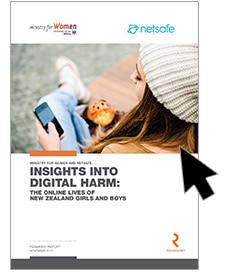Insights into Digital Harm – Research Report
Netsafe and the Ministry for Women have worked together to create a report exploring the differences in the ways young people experience harm online. This research is the first of its kind in New Zealand to investigate gendered differences in online harm from the point of view of girls and boys. It presents young New…

Netsafe and the Ministry for Women have worked together to create a report exploring the differences in the ways young people experience harm online. This research is the first of its kind in New Zealand to investigate gendered differences in online harm from the point of view of girls and boys. It presents young New Zealanders’ experiences of digital risk and digital harm in their own words.
The research identifies promising directions and potential solutions to prevent and reduce digital harm. It does so by investigating young people’s views about their use of digital technologies (such as online platforms); their experiences of harm online; what they currently do to prevent and reduce digital harm; and what they think will help in the future.
Online harm is a complex issue, and can take a variety of forms. The internet provide a space for a unique form of harassment that is easy to create and distribute and difficult to remove.
Young people are still maturing and learning about the world, yet their technical expertise often outstrips that of the adults who seek to support them. We all need better answers as parents, caregivers, family whānau, teachers, friends, service providers and policy makers. This research helps us build the evidence base about what will help to prevent and reduce digital harm.
Some of the findings include:
- Seven in 10 teens have experienced at least one type of unwanted digital communication in the
past year. - Nearly 19 percent of teens experienced an unwanted digital communication that had a negative impact on
their daily activities. The most common consequence was being unable to participate online as they used to, and to go to school or study. - The most common types of unwanted digital communications involved being contacted by a stranger and accidentally seeing inappropriate content online.
- In just over a quarter of cases an unwanted digital communication was related to a wider issue happening offline. This was higher for girls than boys.
- Compared to other ethnic groups, Māori and Pacific teens were more likely to report receiving unwanted digital communications across a range of different types.






